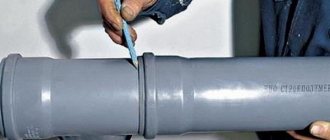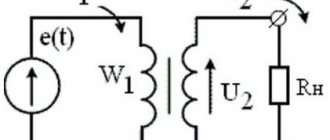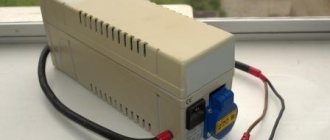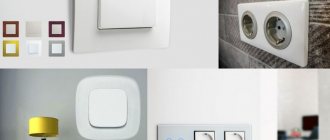In the power supply circuits of old housing stock, you can still find old plugs in the subscriber input panels on electric meters. They are disposable, often burn out and are designed for loads up to 5 A. Therefore, the owners of such houses will sooner or later be faced with the problem of replacing them with circuit breakers. The point is not only in the unreliability of such outdated fuses, the new rules of the Electrical Installation Code, clause 3.1.18 require, when installing intra-house or apartment power lines, to create a protection system that can turn off all conductors at the same time. These requirements today can only be met using a two-pole switch in a 220 V network.
Why do we need to replace traffic jams with automatic machines?
There are 2 types of plugs in use: white, the oldest modifications, and black with a push-button start. According to the existing rules, both one and the other need to be changed by the owner.
Modern circuit breakers do not have the disadvantages inherent in protective plugs. They are able to withstand fairly large short circuit currents (SC) because they have a reliable connection mechanism to the wires. The machine does not need to be changed as often as a plug if it is knocked out. You will simply need to move the lever to the “ON” position, having previously eliminated the original source of overload or short circuit. The reason may not be complicated; usually, the source of a short circuit in a home electrical network is light bulbs due to a burnt-out filament.
If outdated self-acting plugs are able to turn off even when an electric kettle and a household washing machine are turned on together, then the introduction of the latest automatic switches into the line will save users from such an inconvenience. The total current of the two machines is approximately 20 A. The permissible current load on the machines allows you to simultaneously use all light bulbs, a refrigerator, a TV, a PC with a total load of up to 5 A, and additionally connect powerful equipment of 10 A.
Detailed procedure for replacing plugs
Important! Before starting any work with electrical wiring, turn off the power to the apartment! The automatic switch (switch) for turning off the apartment should be located on your staircase.
It also happens that there is simply no machine on the landing (in very old houses). And you can disable an apartment only with all apartments in your riser. The shutdown switch is located either in the basement or on the first floor of the house. A power outage along the riser must be filed with the management company.
Only a licensed electrician can work under voltage. We strongly discourage people who do not understand electricity from working under voltage! This is very life-threatening, do not risk it!
Electricity is out. Unscrew the plugs and remove the plastic covers under the plugs. Now pay attention! Apply voltage (turn on the switch or machine in the entrance). Using the indicator, look where the phase and zero are coming from. [How to use the indicator]. When it comes into contact with a phase (bare wire), the indicator light comes on; if the light does not light, it is a zero or a wire with nothing on it.
READ How to connect internet to tele2 on Android
To understand where the wires come from to the plugs, from above or below, find the incoming phase wire (which is live). The wires on the opposite side of the plugs are the lines of lighting and outlets that run throughout your apartment. Remember the wire layout.
We de-energize the shield again (turn off the switch). We finally unscrew the remaining elements of the plugs (ceramic insulators). We don't cut wires! We carefully clean them from plaque; if necessary, you can wrap the exposed wires with electrical tape.
When removing the plugs, try to exert minimal impact on the wires so as not to damage them, especially for aluminum wires.
At the former place of the plugs, exactly in the middle, using a screwdriver and metal screws, screw the DIN rail. Or we put it on the old bolts that used to hold the plugs.
The disadvantage of this method is that the holes for the bolts are higher or lower from the middle of the old plugs. In emergency cases (no money), you can do without a DIN rail. BUT it will look disgusting, and according to the rules you can’t do that!
For convenience, we cut off the pass-through (duplicate) neutral wire. If it is not clear, take a closer look at the picture above (2nd blue wire). This is done for further convenience of screwing the neutral wire to the neutral bus. We do not touch the same phase wire, so that later we do not have to make a jumper between the machines.
Having screwed the DIN rail, we install two machines and a zero bus on it. For example, we took two machines with a rating of 10 and 16 amperes.
A 10-amp machine is designed for a load of 2200 watts. This is enough for full lighting, even in a four-room apartment. On the line of sockets in old wiring, we recommend installing a package with a rating of no more than 16 amperes (this is 3400 watts of possible load).
For old wiring, it is highly not recommended to install machines with a high rating. Either change all the wiring, or install a new line into the apartment, with the appropriate wire cross-section, for example, for a washing machine or other equipment. Considering that you had Soviet traffic jams , we can conclude that your wiring is in the same condition. Therefore, be sure to look at the ratings of the machines being installed!
| Cable cross-section (copper) | Machine denomination |
| 1.5 mm2 | 16 amps |
| 2.5 mm2 | 20 amps |
| 4 mm2 | 25 amps |
| 6 mm2 | 32 amps |
Incoming phase wires are inserted downwards or upwards into the screw terminal of the machine (packet). From which side of the machine the phase will enter is not important. If the wires come from below, we insert them from below, from above, then from above. If you cut off the duplicate phase wire, then you will have to make a jumper between the machines.
Insert the wire into the clamp and tighten the terminal. We check the reliability of the fastening by tugging the wire with your fingers or a tool. well- clamped wire is the key to stable operation of the machine. On the opposite side of the machines we insert the phases that go to lighting and sockets. We twist it and check it.
Your panel may contain both aluminum and copper wires at the same time. The described scheme for replacing plugs with automatic machines works the same for all types of wires. It must be remembered that you cannot insert two wires of different metals or different sections into one machine or terminal. Copper and aluminum [oxidize], the contact weakens and begins to heat up, until the wiring melts and catches fire. And wires with different cross-sections will not hold properly in the clamp, which will also lead to overheating of the contact.
To the “0” bus we connect the neutral wire that comes along with the phase (initially there were two of them). Since the zero bus is safe, the zero can be open in the shield.
Keep children away from the meter and machines. In emergency situations, any zero can become a phase
That's the whole process of replacing traffic jams with automatic ones.
READ How to connect a local network between two computers via the Internet
If you want to improve fire safety and protect people from electric shock, then an RCD is installed in this circuit.
Acceptable circuit diagrams for connecting machines
The most common scheme for residential electrical inputs is 4 plugs installed above/below the meter. In the old rules, a plug was installed on each wire, on phase and on “0”. Since there is no “0” line in the old residential sector, the wires came from the 380 V access wiring. Therefore, plugs were installed on all lines separately.
The main function of the machines, in the event of a short circuit or overload conditions in the network, is to disconnect all intra-apartment lines from the voltage. To achieve the desired result, you only need to turn off the phase wire; the “0” lines are combined on the “0” bus.
Replacing the machine in the dashboard with your own hands: choosing a plug
Automatic Euro plugs can work effectively and for a long time only if they are properly selected. The choice of plug must be made taking into account the parameters of the electrical circuit and the individual protection requirements of the consumer. What kind of plugs should I put in?
To choose the right automatic equipment you need to:
- Calculate the power of the machine. To do this, you need to take the sum of all household appliances (not forgetting about lighting fixtures) that will work simultaneously, and divide them by the network voltage (220 or 380 V). At the same time, it is advisable to take a new machine with a small power reserve. The most popular are the 16A and 25A machines.
- Make sure that your wiring can withstand the voltage of the machine. This can be done by knowing the cross-section, diameter and material of the electrical wires.
- Decide with the manufacturer. The highest quality, proven equipment is produced by foreign companies Moeller, ABB, Legrand.
It is better to buy automatic devices through official dealers or the company’s sales website. If you need to perform frequent switching off and turning on of electricity, then instead of a conventional machine it is better to choose relays or magnetic contactors.
Compliance with safety regulations
All work on electrical networks may be performed by trained personnel who know the rules for operating electrical equipment and protection methods. A home craftsman must also know the basics of electrical engineering and be able to work with power tools, then replacing plugs with automatic machines with your own hands is acceptable. Otherwise, it is better to entrust this work to specialists. This work is not difficult, and will not cost much, much cheaper than possible troubles due to an electric shock from the performer or a wiring fire.
When installing machines, you will need to follow four basic rules:
- First of all, they carry out the procedure for de-energizing the subscriber input to the house or apartment where electrical installation operations will take place. In the floor switchboard, the package switch that supplies the current supplying the apartment is turned off.
- Check for complete absence of voltage using a multimeter or phase indicator. To do this, unscrew the plugs from the plug holders and make sure that there is no tension in the central and threaded contacts.
- Before testing the voltage, make sure that the meter that will be used for testing is working. To do this, check the outlet, which is known for sure that voltage is supplied to it.
- Insulate the phase wire connected to the electric meter for the installation period.
Replacing plugs with circuit breakers in an old panel - how to do it yourself correctly
Electrical plugs are fuses that were previously installed in electrical networks, serving as protective devices. Often in old apartments there are still Soviet-style plug fuses installed on the meter. They can be ceramic or plastic. Electrical plugs are not highly reliable, and when they fail, a jumper is often placed in the panel, which allows current to pass through, but does not protect against a short circuit and the unpleasant consequences associated with it. To avoid problems, just replace the plugs with circuit breakers. And in this article we will talk about how to replace traffic jams with automatic machines with your own hands.
When it is impossible to remove the input voltage
As a rule, in a one-story private residential sector it is impossible to completely turn off the electricity. The electricity meter at the entrance to the house is constantly energized. In this situation, to carry out work safely, you must disconnect the phase wire from the 1st terminal of the metering device and carefully insulate it.
This operation is performed with the utmost care, wearing dielectric gloves and using tools with insulated handles. Eyes must be protected in the form of glasses or a shield. To ensure the safety of the worker, a rubber mat is placed under the feet.
It is possible to insulate the wires using cambric of the required size. To prevent it from accidentally jumping off, it is fixed using several turns of electrical tape.
Tools and materials
To replace plugs, you can use different types of input panels. The main thing is that all elements of the reconstructed circuit are installed in them technologically correctly. According to the new requirements, the meter readings must be read without opening the box.
Basic tools and devices for replacing electric meter plugs with circuit breakers:
- indicator;
- wire cutters with dielectric handles;
- a set of screwdrivers with dielectric handles;
- round nose pliers with dielectric handles;
- electric screwdriver with self-tapping screws;
- flashlight;
- insulating tape;
- circuit breaker 10–15 A;
- DIN rail 150 mm;
- "0" - bus;
- PPE caps.
When performing installation work, you may need to extend some wires. Existing standards in electrical engineering prohibit connecting wires using simple twisting. They can be connected using special protective PPE clamps, spring terminal blocks, or welding and soldering methods.
Preparatory work
Before starting to modernize a household panel, choose the correct rating of the machine. To do this, you need to know what the total load is carried by the in-house wiring. Typically, the reconstruction of the subscriber input is carried out with the replacement of all electrical wiring in the apartment.
When replacing an electric meter, before starting work, obtain permission to work from the energy company. For this purpose you will need to write an application. After the RES inspector checks the integrity of the seal and records the latest meter readings, permission to replace will be given. After completing the electrical installation work, it is necessary to invite the inspector again to check the correct connection and sealing of the electric meter.
When replacing the electric meter is not required and it is possible to replace plugs on circuit breakers without removing the seal, then the participation of a RES inspector is not required.
Technology for replacing plugs in electrical panels
After completing all the preparatory work, selecting and purchasing circuit breakers and obtaining approval from the distribution zone, you can begin direct installation.
Step-by-step instructions for replacing electrical plugs with automatic ones:
- Turn off the input voltage. For apartments, this is done in the electrical panel located on the landing. In individual households, the input machine is usually located in front of the meter.
- Relieves the load from automatic traffic jams. For this purpose, press the button on them, then unscrew both electrical plugs.
- Check the voltage on the wires using an indicator.
- Disconnect all wires and carefully isolate the live wire when it is not possible to remove the load.
- The plug sockets are completely removed in order to free up space for mounting the DIN rail.
- Install the DIN rail in the shield, securing it with self-tapping screws.
- Connect the circuit breaker on a DIN rail.
- The input wires from the electric meter are routed from the top.
- Connect the phase to the terminal: L, O and N.
- Connect the wires leading to the load from below.
- Turn on the power and check that the replacement is correct.
Possible configurations of plugs and machines in the panel
| Old configuration | New configuration |
| 2 plugs | 1 automatic machine + 1 bus “0” |
| 4 plugs | 2 machines + 1 bus “0” |
| 4 plugs | RCD + 2 automatic devices + 1 bus “0” |
| 6 plugs | RCD + 3 automatic devices + 1 bus “0” |
The most common configuration is four plugs above (or below) the meter. This is exactly what we will describe.
There are two types of corks: white (the oldest) and black (with a button). The presence of certain plugs you have does not in any way affect the process of replacing them. They, like all old things, go to the trash heap (to a museum or an antique shop).
The first question that people have is: why, instead of four traffic jams, is it enough to install two automatic machines?
Each machine is installed on its own line (a line is two wires in a cable - phase and zero). And only a phase wire (live wire) is inserted into each machine.
It is not recommended to insert neutral wires into the machine. All "0"s are connected on the zero bus.
In ancient times, a plug was installed on each wire, both zero and phase. This is because in old houses there simply was no “0”. And the wires coming into the apartment from the entrance were energized (three-phase circuit in old houses). Therefore, a plug was needed for each wire.
The main task of the machines, in the event of a short circuit or overload, is to de-energize the apartment. To do this, it is enough to disconnect only the phase wire, because it is safe to set the machine to zero and it is not recommended to set it to “0”. Zero by its nature is “ground” (what is grounding).
Second question. What to do with the wires that go to the plugs? Do I need to change the meter?
If you are not going to completely change the wiring in the apartment, then you don’t need to do anything. Just change the plugs automatically, being careful not to damage the old wires.
If you are changing the meter [replacing the meter], then it is advisable to change the wires that come from the meter too. Since once the meter is sealed, it will be impossible to change the wires without damaging the seal. If possible, change all the old wires and the meter. Do-it-yourself replacement of old wiring
RCD connection
In order to protect people from dangerous electric shock, for example, in case of unintentional contact with a bare section of wire or breakdown on the body of a household electrical appliance, experts strongly advise additionally including an RCD in a single home or apartment network.
Such a protective device bases its operation on constant monitoring of the balance of currents flowing through the electrical appliance. When a current leak occurs on the housing of household equipment or on the ground, the balance is upset. The RCD detects such an imbalance, trips, thereby interrupting the electrical circuit and de-energizing the load in the house.
Thus, replacing old plugs with automatic ones is considered a necessary process, since it increases the reliability of power supply to consumers and improves the conditions for safe living in the house. The work must be performed by trained craftsmen, in addition, preliminary approval from the RES inspection will be required.
Features of choosing circuit breakers and power cables
Sometimes people, having come to the conclusion that it is necessary to replace old safety elements, install automatic plugs instead. This is due to the interchangeability of these devices and the identical installation, so the replacement procedure can be carried out in the shortest possible time. But we do not recommend doing this. Although the circuit breaker and the automatic plug have the same principle of operation, the reliability of the latter is rather low.
It is best to opt for circuit breakers - they are of much higher quality and more durable. In addition, they are presented in stores in a wide range, and choosing a protective device for any network will not be difficult.
Before we talk about how old plugs are replaced with circuit breakers, let’s figure out how to choose the right type of circuit breaker. To do this, you need to calculate the total power of electrical appliances included in the home network. A good example in the video:
Let's assume that the apartment has:
- Refrigerator (400 W).
- Hob (7000 W)
- Microwave oven (1800 W).
- TV (200 W).
- Washing machine (700 W).
- Lighting fixtures (500 W).
Adding up the power of all the listed devices, we get 10600W. The standard voltage in household networks is 220V. We calculate the load current using the formula I=P/U, 10600/220=48.18A. Based on the ratings of commercially available circuit breakers, we can say that to protect such a network you will need a 50A circuit breaker.
But that is not all. Before installing automatic plugs instead of electrical plugs, you need to make sure that the wiring can withstand the load that home appliances will provide. To make it easier to select the cable cross-section, we provide a table.
Based on the data presented, you can easily select the desired conductor cross-section. In our example, you need to choose a copper wire of 11 square meters. mm or aluminum for 12.1 sq. mm.











